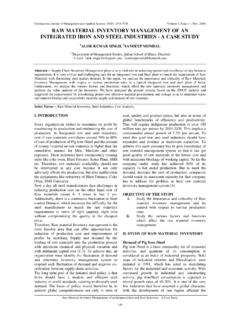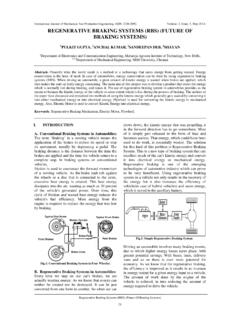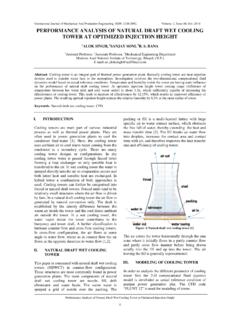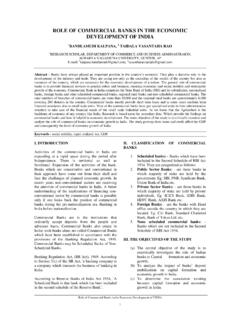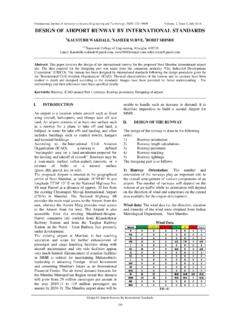Transcription of DEVELOPMENT OF WIRELESS BIO-TELEMETRY …
1 International Journal of Electrical, Electronics and Data Communication, ISSN: 2320-2084 Volume-2, Issue-3, March-2014 DEVELOPMENT of WIRELESS BIO-TELEMETRY system using FM Stereo Method 42 DEVELOPMENT OF WIRELESS BIO-TELEMETRY system using FM STEREO METHOD 1 MANDEEP SINGH OBEROI, 2 UMANG PURI, 3 ASHUTOSH SHUKLA, 123*Department of electronics, Bhartividhyapeeth college of engineering, Pune E-mail: Abstract- DEVELOPMENT of telemetry system is used for Transmission and detection of vital body signals. The transmitting unit detects and sends two kinds of patient s vital signals. The stationary receiving unit receives and analyzes the signals and alerts a nurse to the dangers of the patient if necessary. The system could be simplified and minimized in size by using commercialized electronic components. The main aim of this project to inform doctor about patient condition continuously. In this project two parameters namely temperature and heart rate are measured.
2 Abnormality in any one of the parameter will be informed to the doctor through FM receiver. The main aim of this project to inform doctor about patient condition continuously. In these project two parameters namely temperature and heart rate are measured. Abnormality in any one of the parameter will be informed to the doctor through FM receiver. Temperature is sensed by using , two terminal IC AD590 which gives current output directly proportional to absolute temperature variations. This is amplified using instrumentation amplifier, and read to analog and digital converter. A microphone sensor is used to detect patient s heart sound. The standard FM stereo modulation method and a commercialized single IC chip were incorporated to reduce the size of the transmitter and increase signal-to-noise ratio. In the receiving unit a standard FM receiving module could be used to restore the original signal with very low cost.
3 After detecting, the signal is processed by digital filters, and the extracted patients parameters are displayed on CRT monitor. I. INTRODUCTION1 Biotelemetry is defined as the transmission of biomedical signals and parameters to a remote recorder by means that do not cause substantial disturbances and restraints to the human being monitored. The classification of systems is based on the technical principle of transmission ( , WIRELESS or by wire, radio wave, ultrasonic wave. or light wave). Further classification is according to the range of transmission, number of simultaneous data channels, modulation technique, and application. Telemetric transmission of functional and physiological information offers many advantages in medical diagnostics and patient surveillance .The telemetric data link avoids direct connections to the recording or monitoring equipment, which are sometimes embarrassing and restraining, thus leaving the patients freely movable.
4 They can be monitored in their natural environment and during work. Accordingly, the measurement does not influence the physiologic system under study. Thus avoiding severe artifacts. This advantage is especially important in behavioral studies involving both humans and animals. Implantable telemetry systems transmit internal physiologic signals. Or serve' to control and program implanted devices. Such as stimulators and drug infusion systems. Without the need of transcutaneous wire connections which always carry the risk of infection. Depending on the distance between patient and remote recorder, on-wire transmission is realized either as a direct connection between transducer and recorder or uses interference-reducing pre amplifier-driven cable connections. WIRELESS telemetry transmits the signals by modulation of a carrier wave that serves as a transmission link.
5 Besides the commonly used battery-operated systems, passive telemetry transmitters, which do not require any power supply, exist for applications in long-term implantable devices, offering unlimited operation times. II. METHODOLOGY telemetry is defined as the sensing and measuring of information at some remote location and then transmitting that information to a central or host location. There, it can be monitored and used to control a process at the remote site. The basic concept of telemetry has been in existence for centuries. Various methods of transmitting data from one site to another have been used. telemetry using radio waves or WIRELESS offers several distinct advantages over other transmission methods. Some of these advantages are:. Faster response time No transmission lines to be cut or broken Lower cost compared to leased lines Ease of use in remote areas where it is not practical or possible to use wire or coaxial cables Easy relocation Functional over a wide range of operating conditions.
6 International Journal of Electrical, Electronics and Data Communication, ISSN: 2320-2084 Volume-2, Issue-3, March-2014 DEVELOPMENT of WIRELESS BIO-TELEMETRY system using FM Stereo Method 43 Properly designed radio links can provide low cost, effective and flexible data gathering systems that operate for many years with very little maintenance. Components of a telemetry system At the remote site, a sensor or sensors are typically the data source. The output of the sensors is converted to digital data by a small computer device or RTU (Remote Terminal Unit). The RTU is interfaced to a modem device that converts the digital data into an analog signal that can be transmitted over the air. The radio transmitter then transmits the signal to the host site radio receiver. Now the process is reversed. The modem takes the analog signal received and converts it back to a digital form that can be processed by the data recovery equipment.
7 In a typical application, the base or host site requests data from the remote sites. The base transmits a request to the remote unit telling it to send its data. The base reverts to a receive mode and awaits the transmission from the remote site. After the remote sends its data, it goes back to a receive mode waiting for further instructions to come from the base. Once the base receives the remote site information, it may send additional instructions to that site or continue on to request data from the next remote site. This polling process continues until all the remotes in the system have sent their data. III. PROPOSED METHODOLOGY:- Figure 1 IV. DESCRIPTION The general block diagram is shown in the figure 1. It consists of the following blocks. Temperature measuring part Heart Sound-Detecting part Microprocessor kit Telecommunications part 1) TEMPERATURE MEASURING PART It consists of temperature sensing transducer which converts temperature into its equivalent voltage; this voltage is further amplified by instrumentation amplifier and fed to analog to digital converter.
8 The two terminals IC AD590, used for temperature sensing, of which current output which is directly proportional to absolute temperature variations, over a range of -50 C to +150 C. The projected output of the AD590 varies at the rate of 1 A/K and is inherently linear, thus requiring no external linear circuit. Please not that zero degree centigrade is equal to K. The IC is pre-calibrated to give an output of A at K but external calibration can also be performed. Thus the temperature sensor works over a wide range of voltages, starting from +4v to +40v, which adds to the versatility of its application in various temperature sensing circuits. The current output of the transducer needs to be converted to suitable proportional voltage level 2) HEAR SOUND SIGNAL The heart sound signal to be detected by a microphone sensor is frequency-modulated by voltage-controlled oscillator and fed to the microprocessor and then to left audio channel input of the standard frequency modulation IC (BH1416F, Rohm).
9 The sensor for the heart sound detection will be designed by using a condenser microphone and should be attached on the body surface. Heart sounds can be utilized more efficiently by medical doctors when they are displayed visually, rather than through a conventional stethoscope. A system whereby a digital stethoscope interfaces directly to a PC will be described along with signal processing algorithms adopted. The sensor is based on a noise cancellation microphone, with a 450 Hz bandwidth and is sampled at 2250 samples per second with 12-bit resolution. Further to this, we discuss for comparison a piezo-based sensor with a 1 kHz bandwidth. A major problem is that the recording of the heart sound into these devices is subject to unwanted background noise, which can override the heart sound and results in a poor visual representation.
10 This noise originates from various sources such as skin contact with the stethoscope diaphragm, lung sounds (patient breathing), and other surrounding sounds such as speech. Furthermore we project a solution using wavelet denoising. The wavelet transform is used because of the similarity between the shape of wavelets and the time-domain shape of a heartbeat sound. Thus coding of the waveform into the wavelet domain can be achieved with relatively few wavelet coefficients, in contrast to the many Fourier components that International Journal of Electrical, Electronics and Data Communication, ISSN: 2320-2084 Volume-2, Issue-3, March-2014 DEVELOPMENT of WIRELESS BIO-TELEMETRY system using FM Stereo Method 44 would result from conventional decomposition. We project that the background noise can be dramatically reduced by a thresholding operation in the wavelet domain.

